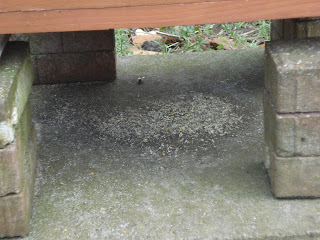For the last 10 days I have been counting the number of varroa mites dropping off the bees on to the hive floor. The daily average was 0.3 which suggests there are between 35 and 130 adult mites in the colony. That's not usually regarded as high enough to warrant intervention, but I decided to treat my bees for two reasons:
- It's been very windy so some dead mites may have been blown away
- The cluster of bees is fairly small so the mite density is higher than 'average'
Varroa mites kill bees and also spread nasty viruses so timely treatment now should help my little colony to be in top condition by spring. The problem is there are so few treatment options. The mites in this area are resistant to approved mitocides and it's too cold to use thymol, so instead I have resorted to oxalic acid which is the bee-equivalent of napalm!
I'm not kidding: Acid is added to a sugar solution and then poured over the bees - it's sticky and it burns.
Get it right and the acid is just strong enough to burn the claws off those horrid varroa mites so that they drop off the bees, but if you get it wrong you will have a smoking pile of dead bees.
Non-scientists are best advised to purchase a commercially prepared solution, but my reading of the literature suggests that these are too potent for bees in our climatic zone, so I make my own.
I just hope I've got my maths right....






